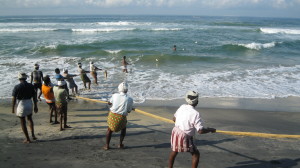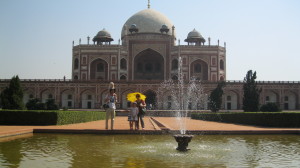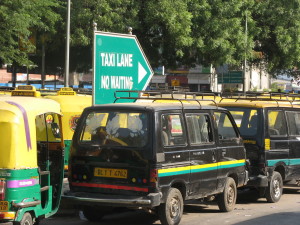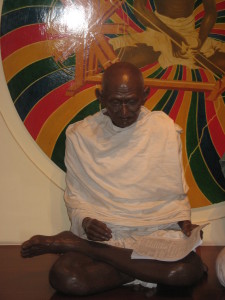Balvinder Singh, son of Punjab Singh, Prince of Taxi Drivers, may your moustache never grow grey! Nor your liver cave in with cirrhosis. Nor your precious Hindustan Ambassador ever again crumple in a collision – like the one we had with the van carrying Mongo Frooty Drink.
Although during my first year in Delhi I remember thinking that the traffic had seemed both anarchic and alarming, by my second visit I had come to realize that it was in fact governed by very strict rules. Right of way belongs to the driver of the largest vehicles. Buses give way to heavy trucks, Ambassadors give way to buses, and bicyclists give way to everything except pedestrians. On the road, as in many other aspects of Indian life, Might is Right.
Yet Mr Balvinder Singh is an individualist who believes in the importance of asserting himself. While circumstances may force him to defer to buses and lorries, he has never seen the necessity of giving way to the tinny new Maruti vans which, though taller than his Ambassador, are not so heavily built. After all, Mr Singh is a Kshatriya by caste, a warrior, and like his ancestors he is keen to show that he is afraid of nothing. He disdains such cowardly acts as looking in wing mirrors or using his indicators. His Ambassador is his chariot, his klaxon his sword. Weaving into the oncoming traffic, playing ‘chicken’ with the other taxis, Balvinder Singh is a Raja of the Road.
– William Dalrymple, City of Djinns
In his description of Balvinder Singh of the International Backside Taxi Company, William Dalrymple captures perfectly the bizarre miracle of India. Somehow, amidst all the chaos and confusion, the conglomeration of cultures, colour and beliefs, the hierarchies of class, wealth and power, the violent aggression and diffident subservience, it works. We, too, have held our breath as our auto-rickshaw weaves its way in and out of the screaming, honking buses, lorries, cars and motorbikes, and sat, sweltering in an hour-long traffic jam, clinging desperately to the hope that somehow something will shift and the pulsing, sweating throng once more move forward.
 It is a land of incredible contrasts. From the pollution-hazed grime of Delhi’s streets, to glorious sunsets over the Indian Ocean; from the reeking stench of piles of rotting garbage to the elegant splendour of Moghul tombs; from obsequious bureaucracy to a flexible can-do attitude; from the demeaning poverty of begging women and children at the traffic lights to the sacrificial beauty of Mother Teresa’s Missionaries of Charity; from the ugly violence of the 1984 massacres, brutal imperialism, and ongoing racial and religious bigotry to the powerful simplicity of Gandhiji’s Satyagraha.
It is a land of incredible contrasts. From the pollution-hazed grime of Delhi’s streets, to glorious sunsets over the Indian Ocean; from the reeking stench of piles of rotting garbage to the elegant splendour of Moghul tombs; from obsequious bureaucracy to a flexible can-do attitude; from the demeaning poverty of begging women and children at the traffic lights to the sacrificial beauty of Mother Teresa’s Missionaries of Charity; from the ugly violence of the 1984 massacres, brutal imperialism, and ongoing racial and religious bigotry to the powerful simplicity of Gandhiji’s Satyagraha.
Over the past two weeks I have seen and read of some of the worst depravities of human kind, been confronted with the truth of my own prejudice and greed, and wept at the relentless, harsh grind of daily life for so many millions. No platitudes can take away those hard realities. But through it all, perhaps, there remains a glimmer of hope, a vision of a different India, of a world renewed. A world where, perhaps, Gandhiji’s dream of India can become a new reality:
An India in which the poorest shall feel that it is their country, in whose making they have an effective voice, an India in which there shall be no high class and no low class of people, an India in which all communities shall live in perfect harmony.



Hello Peter – good to hear a bit about your experiences of India. As an avid traveller (I’ve been to India about 16 times) it remains my favourite place. All it’s frustrations, corruption and tragedy are always outweighed by the colour and vivacity that stay with you long after you’ve returned, as does the grace and amazing resilience of the people.
Have you read Katherine Boo’s “Behind the Beautiful Forevers” which brings these contradictions in Mumbai right up against each others’ faces ?
Hope you are well ….. Marion.